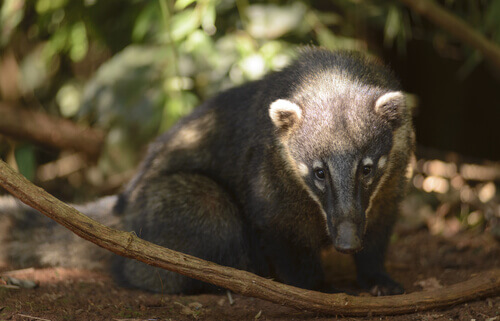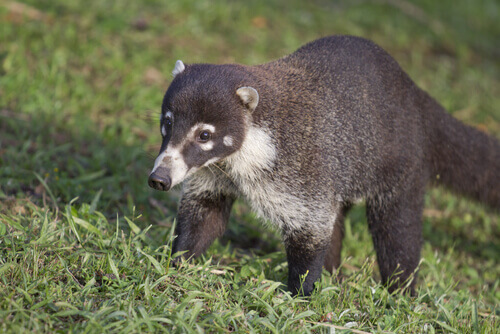All About Badgers: Characteristics, Habitat and Behavior

Famed for their digging ability, badgers are medium-sized carnivorous mammals characterized by their long snouts and black and white faces. Here you’ll learn all about badgers and their characteristics, habitat and behavior.
Badgers’ main characteristics
Stocky animals with short tails and bodies which are longer than they are tall, badgers have long, triangular heads, measure about 2.5 feet long and weigh up to 34 pounds.
Their legs are very short, but at the same time quite strong, especially the front ones. The snout moves quickly and can dig and root very well.
Their coats are part gray and part jet black; their abdomens and legs are black and they have a white head with two long, thick black stripes. Both the edges of their ears and the tip of their tails are white.
Each spring they lose a lot of hair, which is very soft. It’s often used to make paintbrushes and shaving brushes.
Badgers’ habitats and food
This animal prefers semi-arid and high mountain areas, and forests with some plant cover but with clearings and pastures where they can find food. They mainly eat worms, insects, and fruit, although, because they’re omnivorous, their diet can include bees, small reptiles, corn, carrion, vegetables, and invertebrates.
The badger is an ancient species; zoologists believe they’ve inhabited Earth for millions of years. Important subspecies live in the Iberian Peninsula and even in the Pyrenees. They live all over Europe, with the exception of northern Scandinavia.
Badger behavior
These nocturnal creatures come out at dusk and are rarely seen during the day. They swim fairly well and can climb trees – they also run fast. When they feel threatened or detect danger they howl loudly.
The badger’s eyesight is not very well-developed because they evolved living in caves and moving about only at night. However, to compensate for this, they developed excellent hearing and, above all, a finely-tuned sense of smell.
They’re very sociable animals that live in groups of between 2 and 12 individuals, half of which are adults. They like to play with each other and help each other with hygiene rituals.
‘Clans’ of up to two dozen individuals live together in underground homes that they dig known as setts. These can be extensive and even have separate ‘rooms’: a main chamber which can be up to 13 feet high, ventilation ducts for clean air, escape tunnels in case of floods or other dangers, toilets for defecation, and a special crib for the cubs.
How they reproduce
The females stay longer in the sett than the males; in fact, they usually remain in the sett where they were born for their whole life.
The social group is composed of a dominant male and female and their subordinate descendants. All females can mate with the dominant male, but the dominant female is the only one who has cubs.
Mating takes place between spring and summer and copulation lasts about 90 minutes. The female has the ability to ‘store’ the fertilized egg for several months. Gestation lasts 65 days and each litter can have between two and six cubs. At birth, the cubs have white hair on their bodies and black hair on their heads.
The mother breastfeeds her cubs for three months, during which time she barely leaves the sett. The male doesn’t help take care of the cubs. Moreover, even after this stage the young remain in the same ‘room’ and the mother continues to watch over them.
Famed for their digging ability, badgers are medium-sized carnivorous mammals characterized by their long snouts and black and white faces. Here you’ll learn all about badgers and their characteristics, habitat and behavior.
Badgers’ main characteristics
Stocky animals with short tails and bodies which are longer than they are tall, badgers have long, triangular heads, measure about 2.5 feet long and weigh up to 34 pounds.
Their legs are very short, but at the same time quite strong, especially the front ones. The snout moves quickly and can dig and root very well.
Their coats are part gray and part jet black; their abdomens and legs are black and they have a white head with two long, thick black stripes. Both the edges of their ears and the tip of their tails are white.
Each spring they lose a lot of hair, which is very soft. It’s often used to make paintbrushes and shaving brushes.
Badgers’ habitats and food
This animal prefers semi-arid and high mountain areas, and forests with some plant cover but with clearings and pastures where they can find food. They mainly eat worms, insects, and fruit, although, because they’re omnivorous, their diet can include bees, small reptiles, corn, carrion, vegetables, and invertebrates.
The badger is an ancient species; zoologists believe they’ve inhabited Earth for millions of years. Important subspecies live in the Iberian Peninsula and even in the Pyrenees. They live all over Europe, with the exception of northern Scandinavia.
Badger behavior
These nocturnal creatures come out at dusk and are rarely seen during the day. They swim fairly well and can climb trees – they also run fast. When they feel threatened or detect danger they howl loudly.
The badger’s eyesight is not very well-developed because they evolved living in caves and moving about only at night. However, to compensate for this, they developed excellent hearing and, above all, a finely-tuned sense of smell.
They’re very sociable animals that live in groups of between 2 and 12 individuals, half of which are adults. They like to play with each other and help each other with hygiene rituals.
‘Clans’ of up to two dozen individuals live together in underground homes that they dig known as setts. These can be extensive and even have separate ‘rooms’: a main chamber which can be up to 13 feet high, ventilation ducts for clean air, escape tunnels in case of floods or other dangers, toilets for defecation, and a special crib for the cubs.
How they reproduce
The females stay longer in the sett than the males; in fact, they usually remain in the sett where they were born for their whole life.
The social group is composed of a dominant male and female and their subordinate descendants. All females can mate with the dominant male, but the dominant female is the only one who has cubs.
Mating takes place between spring and summer and copulation lasts about 90 minutes. The female has the ability to ‘store’ the fertilized egg for several months. Gestation lasts 65 days and each litter can have between two and six cubs. At birth, the cubs have white hair on their bodies and black hair on their heads.
The mother breastfeeds her cubs for three months, during which time she barely leaves the sett. The male doesn’t help take care of the cubs. Moreover, even after this stage the young remain in the same ‘room’ and the mother continues to watch over them.
All cited sources were thoroughly reviewed by our team to ensure their quality, reliability, currency, and validity. The bibliography of this article was considered reliable and of academic or scientific accuracy.
- Abramov, A. V., & Puzachenko, A. Y. (2013). The taxonomic status of badgers (Mammalia, Mustelidae) from Southwest Asia based on cranial morphometrics, with the redescription of Meles canescens. Zootaxa, 3681, 44–58. . https://pubmed.ncbi.nlm.nih.gov/25232583/
- Del Cerro, I., Marmi, J., Ferrando, A., Chashchin, P., Taberlet, P., & Bosch, M. (2010). Nuclear and mitochondrial phylogenies provide evidence for four species of Eurasian badgers (Carnivora). Zoologica Scripta, 39(5), 415-425. https://onlinelibrary.wiley.com/doi/abs/10.1111/j.1463-6409.2010.00436.x
- Fred, L. (1994). Badgers. En S. Hygnstrom, R. Timm y E. Larson (Eds.), The Handbook: Prevention and Control of Wildlife Damage (pp. C1–C4). University of Nebraska-Lincoln. https://digitalcommons.unl.edu/icwdmhandbook/28/?a_aid=3598aabf
- Garland, T. (1983). The relation between maximal running speed and body mass in terrestrial mammals. Journal of Zoology, 199(2), 157-170. https://zslpublications.onlinelibrary.wiley.com/doi/abs/10.1111/j.1469-7998.1983.tb02087.x
- Gil-Sánchez, J. M., Herrera-Sánchez, F. J., Rodríguez-Siles, J., Sáez, J. M., Díaz-Portero, M. Á., Arredondo, Á., Álvarez, B., Cancio, I., de Lucas, J., Castillo, S., McCain, E., Pérez, J., Valenzuela, G., Martínez Valderrama, J., Bautista, J., Sarabia, C., Leonard, J., Sánchez-Cerdá, M., Virgós, E., & Qninba, A. (2020). Feeding Specialization of Honey Badgers in the Sahara Desert: A Trial of Life in a Hard Environment. Diversity, 12(2), 59. https://www.mdpi.com/1424-2818/12/2/59
- Kollias, G. V., & Fernandez-Moran, J. (2015). Mustelidae. Fowler’s Zoo and Wild Animal Medicine, 8, 476–491. https://www.ncbi.nlm.nih.gov/pmc/articles/PMC7152349/
- Kruuk, H., & Parish, T. (1977). Behaviour of badgers. Institute of Terrestrial Ecology. Natural Environment Research Council. https://nora.nerc.ac.uk/id/eprint/5211/1/Behaviour_Badgers.pdf
- Long, C. A. (1965). Functional aspects of the jaw-articulation in the North American badger, with comments on adaptiveness of tooth-wear. Transactions of the Kansas Academy of Science, 68(1), 156-162. https://www.jstor.org/stable/3626358
- Martín, R., Rodríguez, A., & Delibes, M. (1995). Local feeding specialization by badgers (Meles meles) in a Mediterranean environment. Oecologia, 101, 45–50. https://link.springer.com/article/10.1007/BF00328898
- Minta, S. C., Minta, K. A., & Lott, D. F. (1992). Hunting associations between badgers (Taxidea taxus) and coyotes (Canis latrans). Journal of Mammalogy, 73(4), 814-820. https://academic.oup.com/jmammal/article-abstract/73/4/814/907355?login=false
- Proulx, G. & Do Linh San, E. (2016). Badgers: systematics, biology, conservation and research techniques. Alpha Wildlife Publications.
- Proulx, G., Abramov, A. V., Adams, I., Jennings, A. P., Khorozyan, I., Rosalino, L. M., Santos-Reis, M., Veron, G., & Do Linh San, E. (2016). World Distribution and Status of Badgers — A Review. En G. Proulx y E. Do Lhinh San (Eds.), Badgers: systematics, biology, conservation and research techniques (pp. 31-116). Alpha Wildlife Publications.
- Roper, T. J. (1992). Badger Meles meles setts–architecture, internal environment and function. Mammal Review, 22(1), 43-53. https://onlinelibrary.wiley.com/doi/abs/10.1111/j.1365-2907.1992.tb00118.x
- Rosalino, L. M., Loureiro, F., Macdonald, D. W., & Santon-Reis, M. (2005). Dietary shifts of the badger (Meles meles) in Mediterranean woodlands: an opportunistic forager with seasonal specialisms. Mammalian Biology, 70(1), 12-23. https://www.sciencedirect.com/science/article/abs/pii/S1616504705701488
- Rozhnov, V. V., Korablev, M. P., & Abramov, A. V. (2019). Systematics and Distribution of Ferret Badgers Melogale (Mammalia, Mustelidae) in Vietnam: First Genetic Data. Doklady biological sciences : proceedings of the Academy of Sciences of the USSR, Biological sciences sections, 485(1), 47–51. https://link.springer.com/article/10.1134/S001249661902008X
- Sandell M. (1990). The evolution of seasonal delayed implantation. The Quarterly review of biology, 65(1), 23–42. https://www.journals.uchicago.edu/doi/abs/10.1086/416583
- Sato, J. (2016). The Systematics and Taxonomy of the World’s Badger Species. En G. Proulx y E. Do Lhinh San (Eds.), Badgers: systematics, biology, conservation and research techniques (pp. 1-30). Alpha Wildlife Publications.
- Schulz, R. (27 de julio de 2021). Ökologie-Rekonstruktion seit der letzten Eiszeit: Einbruch in der vielleicht ältesten noch bewohnten Behausung der Welt. Tagesspiegel. https://www.tagesspiegel.de/wissen/einbruch-in-der-vielleicht-altesten-noch-bewohnten-behausung-der-welt-8000557.html
- Silva, M., Rosalino, L. M., Alcobia, S., & Santos-Reis, M. (2021). Sett Use, Density and Breeding Phenology of Badgers in Mediterranean Agro-Sylvo-Pastoral Systems. Animals, 11(9), 2663. https://www.ncbi.nlm.nih.gov/pmc/articles/PMC8471938/
- Yamaguchi, N., Dugdale, H. L., & Macdonald, D. W. (2006). Female receptiveity, embryonic diapause, and superfetation in the European Badger (Meles Meles: implications for the reproductive tactics of males and females. The Quarterly Review of Biology, 81(1), 33-48. https://www.journals.uchicago.edu/doi/abs/10.1086/503923
- Zhou, Y., Newman, C., Kaneko, Y., Buesching C. D., Chen, W., Zhou, Z., Xie, Z., and Macdonald, D. W., Asian badgers – the same, only different: How diversity among badger societies informs socio-ecological theory and challenges conservation. En D. W. Macdonald, C. Newman y L. A. Harrington (Eds.), Biology and Conservation of Musteloids. Oxford University Press.
This text is provided for informational purposes only and does not replace consultation with a professional. If in doubt, consult your specialist.








